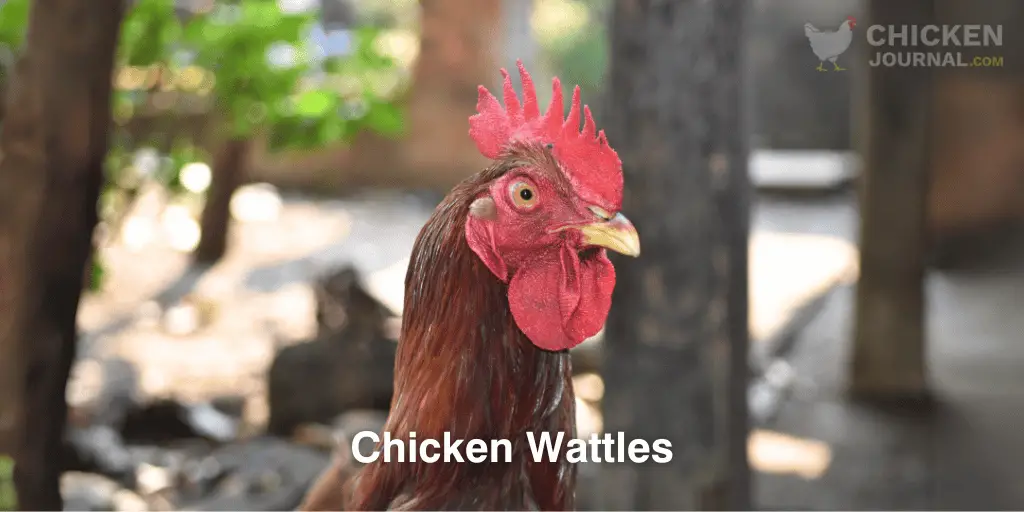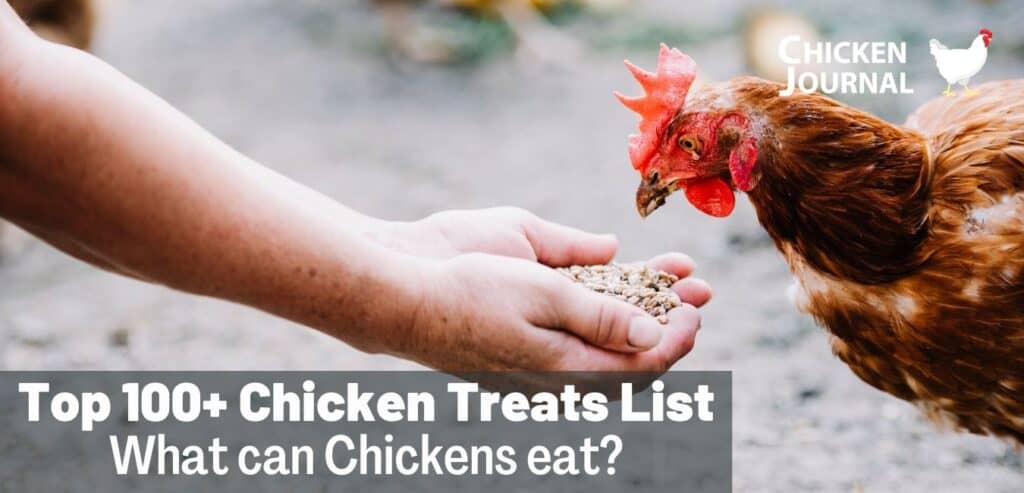Chicken wattles are one of the cool and important parts in a chicken’s body.
Wattles are the red, fleshy things that hang below a chicken’s beak. Though they may seem unimportant, wattles actually do some very essential jobs for chickens.
First, wattles help chickens stay cool when it’s hot outside. When the temperature rises, more blood flows into the wattles.
As this blood circulates back into the chicken’s body, it helps cool the chicken down. This cooling system is really important, especially in warm places, to keep chickens healthy.
But wattles aren’t just for cooling. They’re also a big part of how chickens communicate and find mates.
Healthy chickens tend to have bright, vibrant wattles. When a chicken has nice-looking wattles, it means the chicken is strong and ready to mate.
Other chickens can look at the wattles and know who is healthy and who they might want to mate with. So, wattles are important for chickens to pick good mating partners.
Whether you have chickens as pets or for eggs or meat, it’s good to understand how wattles work.
Healthy wattles mean a healthy chicken. But if a chicken’s wattles look weird, it could be an early sign that something is wrong. Knowing about wattles can help make sure your chickens stay healthy and happy.
This guide covers all you need to know about chicken wattles. You’ll learn what they are and why they’re significant for your chickens.
You’ll also find tips on keeping your flock’s wattles looking great. Whether new to chickens or an expert, these details will prove useful.
Also read: A definitive guide to the chicken comb
The Basics of Chicken Wattles
Every year, many people join the chicken farming businesses, and a few are becoming pet chicken raisers.
That’s why basic knowledge about chicken wattles is essential.
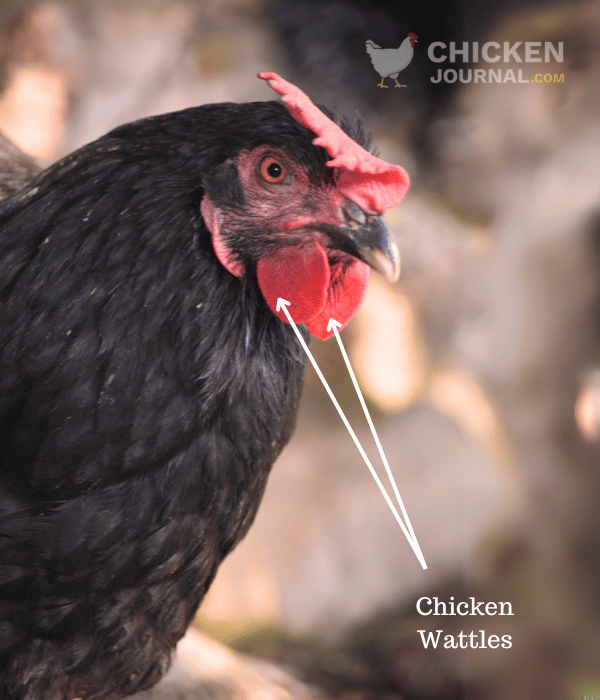
What Are Wattles?
Wattles are fleshy bits that hang under chickens’ necks. They come in different sizes and shapes based on the breed.
They’re usually red or pink. Wattles have soft tissue covered by skin. Along with combs (the fleshy crest on top of chickens’ heads), they help regulate body temperature.
The extra surface area from wattles lets blood flow, which releases heat when exposed to air. This cools down the chicken’s body temperature.
Wattles vs. Combs: Similar but Different
While wattles and combs are often talked about together, they do different things, but are both vital for chicken health.
Both have lots of blood vessels, which aid cooling through heat exchange. But the comb, on the head, also shows rank; bigger, brighter combs mean higher status in the pecking order and more attractiveness to mates.
Though different, changes in wattle and comb color, texture, or size can warn of illness, stress, or environmental issues early. Knowing about both is vital for proper chicken care.
Different Chicken Breeds Have Different Kinds of Wattles
A chicken’s wattles can look very different depending on its breed. Let’s examine three breeds and see how their wattles are unique.
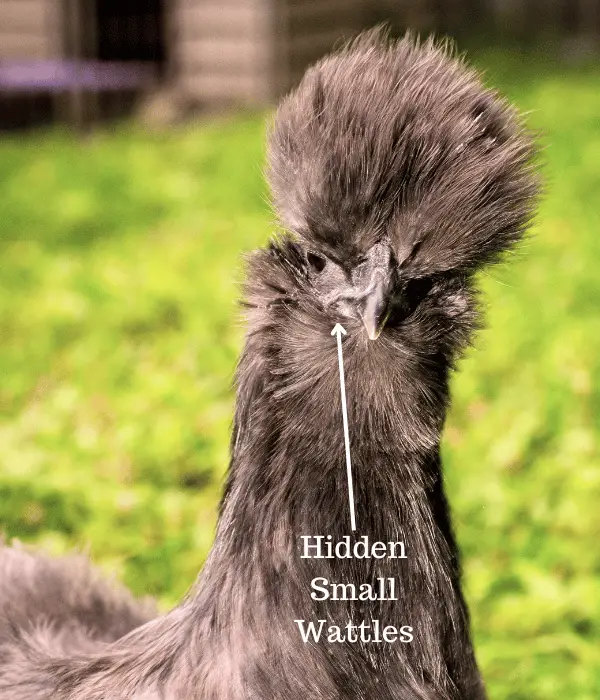
Silkie Chicken Wattles: Silkies have fluffy feathers that typically cover their small bluish wattles. Their wattles aren’t as big or noticeable as those of other breeds, but their cute, fuzzy look makes them popular pets and show birds.

Leghorn Chicken Wattles: Leghorns lay a ton of eggs! They have big, bright red wattles that stand out against their white feathers. Their large wattles help them stay cool and show they’re healthy and strong.

Easter Egger Chicken Wattles: Easter Eggers aren’t really a breed – they’re a mix of chickens that lay colored eggs. Their wattles can vary in size and color because of their mixed backgrounds. Generally, they have medium-sized, well-defined wattles that make them look unique.
The different wattle styles show how chickens have adapted over time. Each wattle variation helps the chickens in some way: like staying cool, showing health, or just looking cool!
Understanding wattle differences helps breeders and chicken owners keep their flocks healthy and productive.
Wattles in Chicken Breeding, Growth, and Behavior
Here are a few common roles of wattles in a chicken’s life:
Mating and Social Roles
Wattles, the fleshy growths on chickens’ faces and combs aren’t just decorative features.
They play a crucial part in mating choices and establishing social rankings. These physical traits reveal a bird’s overall condition, influencing its mating success and status within the flock.
Mate Selection: Healthy, vibrant wattles signal strong genetics and immunity to potential mates. Hens tend to choose roosters with larger, redder wattles, as these traits suggest the rooster can produce fit offspring. This breeding preference helps propagate desirable genes in the population.
Pecking Order: The “pecking order” hierarchy is partly determined by wattle and comb size. Birds with more prominent wattles typically rank higher, getting first access to resources like food, nesting spots, and mates. This ordered system maintains stability and minimizes conflicts.
Wattle Development
Wattle growth begins early in a chick’s life and progresses as it matures. Their development is closely tied to the bird’s overall growth and health.
From a couple of weeks old, chickens start growing those hanging fleshy parts or wattles. However, the wattles keep growing bigger as the chicken gets older, reaching their full size around 4-6 months of age.
Different breeds and individual chickens might take slightly different times to develop their wattles fully. Some may take 1 year to grow fully.
Several things affect how a chicken’s wattles grow, including:
The breed of the chicken: A chicken’s genetics play a major role in determining the size and shape of its wattles.
The quality of the chicken feed: Getting enough protein, vitamins, and minerals helps wattles grow properly.
Living in a healthy environment: Diseases or parasites can slow down wattle growth or cause abnormalities.
Favorable climate conditions. Extremely hot or cold temperatures and humidity levels can impact how wattles look and develop.
Nutritional and Environmental Impact on Chicken Wattles

Below are some wonderful facts about chicken wattles connected with nutritional and environmental impact:
What Chickens Eat Matters for Chicken Wattle Health
What your feathery friends feed on significantly impacts the well-being and vibrant appearance of their wattles.
A balanced, nutrient-packed diet is the key to maintaining wattles in the best condition, reflecting your chickens’ overall health and enjoyment.
Protein is essential for growth and repair and plays a crucial role in the development and upkeep of the wattle. Give protein treats like mealworms, and you’ll see that those wattles shrink in color.
Vitamins A, E, and D, along with minerals like zinc and selenium, are real MVPs when it comes to skin health and immune function. Ensure your flock gets enough vitamins and minerals in their feed and as a supplement.
Dehydration can cause droopy wattles. Constant access to fresh, clean water keeps those wattle healthy, turgid, and free from cracks or dryness.
Coop Management for Wattle Wellness
Wattles aren’t just affected by their feed – their environment plays a huge role too. Understanding how factors like temperature, humidity, and housing conditions influence wattle health can help create the perfect cozy place to live for your birds.
Extremely hot temps can lead to heat stress, with wattles going limp and pale as they try to release body heat.
On the other side, frozen conditions put those big, exposed wattles at risk of frostbite. Providing shade, ventilation, and toasty warmth can help your flock deal with these wattle issues.
Humid conditions, especially when paired with soaring temperatures, pose a severe threat to chickens’ well-being.
The hot and muggy air can trigger heat stress and respiratory complications, indirectly harming their wattles. Proper airflow and dry bedding are necessary for maintaining a healthy living space.
Cramped or poorly-ventilated coops cause stress, disease transmission, and accidental injuries – any of which could negatively impact wattle condition.
Allocating ample room, ensuring fresh air circulation, and keeping the housing clean are essential to avoiding these issues.
Overcrowding and environmental stressors can also instigate aggressive pecking behaviors and bullying incidents, potentially damaging or injuring the wattles.
Implementing flock enrichment strategies and vigilantly monitoring group dynamics can reduce such undesirable wattle problems.
Fun Facts and Myths About Chicken Wattles
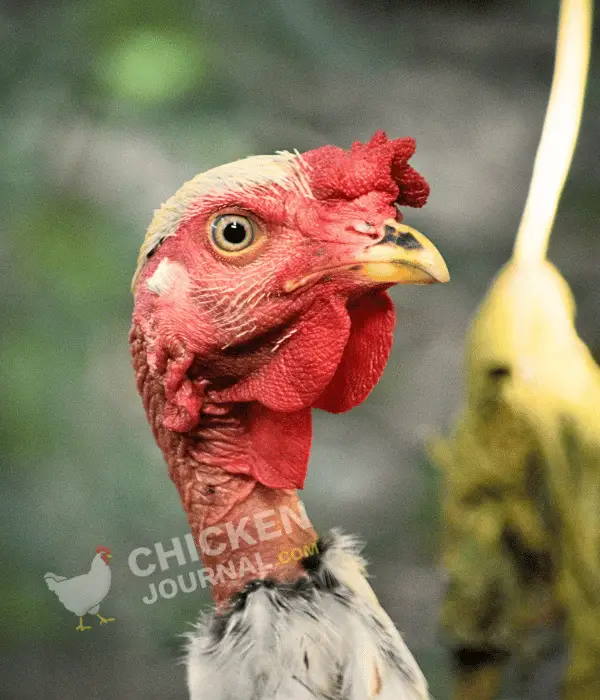
Can You Eat Chicken Wattles?
The idea of eating chicken wattles might seem unusual or even unappetizing to some, but in many cultures worldwide, chicken wattles are considered a delicacy.
They are edible and often used in various traditional dishes, valued for their unique texture and flavor.
When prepared correctly, wattles can be a tasty treat. They are commonly featured in stews, soups, and other slow-cooked meals.
This culinary practice showcases the diverse ways in which different cultures utilize every part of the chicken, adhering to a philosophy of minimizing waste.
Are Chicken Wattles Edible and Do They Grow Back?
Chicken wattles are indeed edible and sometimes sought after for their gelatinous texture when cooked.
This part of the chicken is rich in collagen, similar to other connective tissues, and can provide a unique element to certain recipes.
As for regeneration, chickens can’t regrow lost or damaged body parts, unlike some reptiles and amphibians.
Why Do Chickens Have Wattles?
The presence of wattles in chickens serves several psychological purposes, primarily related to thermoregulation and social communication.
Wattles help chickens cool their bodies, which is important for survival in warmer climates.
Their wattles and combs help chickens talk without words. They show the flock if a chicken is healthy and ready to find a mate. Bright, well-shaped wattles mean a strong chicken.
These birds are likely to be popular with potential partners and leaders in the pecking order.
It is important to understand chicken wattles in order to avoid wrong information.
Troubleshooting Common Problems With Chicken Wattles

To keep your chicken’s comb healthy and well-structured, follow these tips:
Stopping Chickens from Fighting
Chickens can get aggressive with each other, leading to hurt wattles. This happens when they’re stressed, cramped, or figuring out their place in the flock.
Ensure your coop and run give all your birds enough space to move around comfortably. Overcrowding causes tension and fights.
Adding perches, dust baths, and other scratching chicken toys can stop boredom that leads to pecking.
Chickens might bully each other when competing for resources. Separate aggressive hens for a bit to calm things down. Reintroduce carefully to prevent more trouble.
Sprays that taste bad can discourage pecking behavior safely for your flock.
Frostbite Wattles
Wattles are prone to frostbite in winter, as well as cuts and scrapes. Look for pale, blue, or black wattle areas, signs of frostbite damage.
Warm up gradually and never use direct heat. Bring the chicken into a warmer environment and allow it to warm up slowly.
After warming, apply aloe vera to soothe the skin or Vaseline to protect from further cold exposure. Avoid rubbing or massaging the affected area.
Professional medical advice is necessary for severe cases to prevent infection or further damage.
Treating Cuts and Abrasions
Gently clean the wattle with a mild or saline solution, and dilute the antiseptic to remove dirt and bacteria.
To prevent infection, apply a thin layer of antibiotic ointment or wound spray. Choose a product safe for chickens.
Keep an eye on the injury for signs of infection, such as swelling, redness, or discharge.
If possible, isolate the injured chicken from the flock until the wattle heals to prevent pecking at the wound.
Also read: Definitive guide on chicken first aid kit
FAQs on Chicken Wattles
Why are my chicken’s wattles turning white/black/purple?
White wattles often indicate circulatory problems or anemia, possibly because of nutritional deficiencies or parasitic infestations.
Black wattles, typically a sign of frostbite, especially in colder climates. Immediate care is necessary to prevent further damage.
Purple wattles suggest issues with circulation or respiratory distress, indicating the chicken may not receive enough oxygen. This condition requires urgent attention.
What are the signs of swollen or infected wattles?
The wattles appear larger than normal and may feel warm to the touch. Infected wattles may change color, indicating bruising or blood clotting, especially if they appear red, purple, or have streaks of color.
Wattles that are infected may feel hard or have palpable lumps. There may be pus or a clear fluid leaking from the wattles.
Hens with sore wattles might swing their heads. They may scratch at their wattles too. These behaviors show they feel upset.
Noticing these signs soon helps. Talk to a vet. This stops worse problems.
Conclusion
Wattles are fleshy bumps on a chicken’s face. They aren’t just for show, but help birds stay cool, talk to each other, and select mates.
If the wattles look weird like discolored or swollen, it can mean the chicken is sick. So keep an eye on them! Things like cold weather, poor food, or injuries can mess up wattles.
A sick chicken needs help fast. Some people even eat wattles in certain places!
People who love chickens should keep learning about how to care for them properly. Pay special attention to parts like wattles.
Whether they live on farms, backyards, or ranches – happy, healthy chickens are the goal.
I hope this definitive guide helped you understand all about chicken wattles. What’s your experience?
Share your thoughts about wattle problems in your chicken coop.
